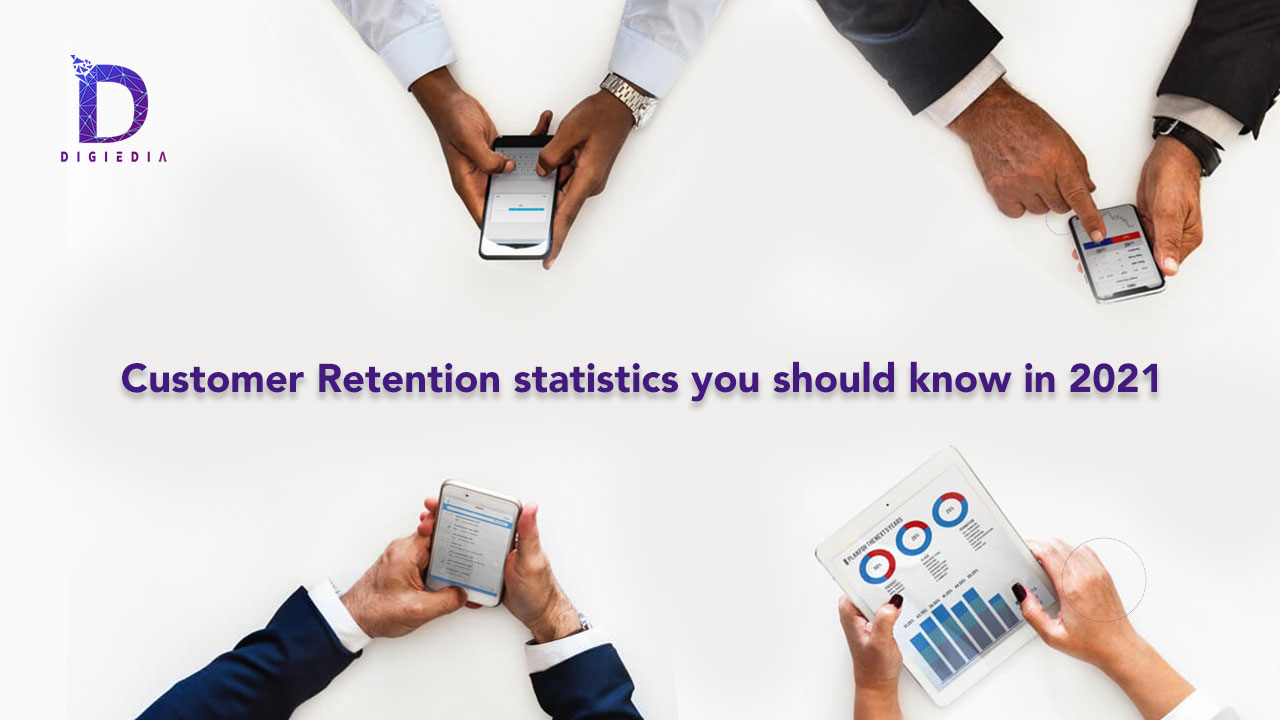
Customer Retention statistics you should know in 2021.
- DIGIEDIA
- Blogs, Digital Marketing
- 24 October 2021
- No Comments
Hacks for Customer Retention Statistics in 2021
For any organisation and a service provider, it is necessary to function for customer acquisition for revenue generation. Although there is something that is waiting as an alternative or a better option than only partially strategising for customer acquisition. What if the importance is more put on maintaining a stable connection with the customers to secure the bottom line?
Is Customer Retention important?
The percentage calculated from Customer Retention Rate (CRR) reflects the remaining number of customers that you may sustain over a given period. This actually signifies the contrast figure of the churn rate, which is actually the number of customers or subscribers you’ve lost over the annual time span. This is the fact why CRR records are important for the track of the loyal customers.
The purpose of Customer Retention is to build a foundation for the clients because generating only one-time purchases shouldn’t be the only goal. It is quite often for a business to spend more resources to reach a client, and these striking expenditures quite possibly nullify any profit which the company gains from their sale. Instead of this practice, the focus should be put on relationships by building a bridge with your active clients and customers to expand the scope of profitability. The reasons are :
- The probable chances of a pre-existing client to make a purchase is about the rate of 60 to 70 per cent. Again if that is for a fresh outlook, the likelihood of your sale reduces to a rate between 5 to 20 per cent.
- Almost a level of eighty per cent in a business’s future turn-over comes from only the 20 per cent of those existing customers who are the long-term stakeholders as well.
The process of implication of a customer’s retention plan of action is of vital importance for any wholesome corporation that wants to make the maximum of its profit. Although it is important to note that planting a loyal customer base is not a trouble-free goal because often customers can be of fickle-minded or not of constant nature. What could be the probable factors that affect the rate of retention, and how do the factors contribute to the achievement of the churn? The identification of these factors is a critical job in looking for the areas which you need to take notice of the most.
- Customer’s Satisfaction: Satisfaction received from the customer is of key importance as it will always be uttered by both the state of expectations from the customer along with the standard of their experiences. The experience level that the customers meet or exceed expectations leads to satisfaction while failing to achieve them leads to churn.
- Success from the Customer: Customer-driven success is highly reliant on how the organisation can state their struggle points. As long as the business is able to reach its targeted goals through the products or services provided by them, then the consumers will most likely continue to stay as long-term customers or clients.
- Customer’s Dependency: Mostly the customers depend on how your products and services are, because of which the harder it becomes for the customers to withdraw interest and look for better alternatives.
- Attachment: Most of the business structure is designed to lock customers through product-oriented contracts which make it costlier to leave. There is also a better option, rather a positive trend of doing it, which is by offering your clients incentives which would bound them to stay longer for improvising retention.
Steps to Measure Customer Retention Rate
Before looking at the statistics of customer retention, let us discuss how to determine the customer retention rate. Have a look at the formula: given below :
CRR = (number of customers at the end of the period) x 100% (number of customers at the beginning of the period)
Now based on the mentioned formula above, you can easily calculate and find out the value of CRR by the mentioned simple steps below:
- To identify the tenure you want to scrutinize and mark the starting and end point of that time period (for eg: August 1st and August 31st).
- To find out the number of how many consumers or clients you had at the initial and end of the time slot, and also the total number of customers you have gained over that time.
- To deduct the number of customers the company has gained from the total quantity of customers at the closing point.
- To fractionate the number by the number of customers the company earned at the starting of the period and then multiply by 100 to get the CRR.
For instance: At the beginning of the month if you had a number of 100 customers, where you have achieved 30 new customers, during that month, after which there is a total sum of 120 consumers at the end period, therefore your retention rate would stand to 90 per cent. Here is how it would look:
CRR = 120-30 x 100%
100
= 90 x 100%
100
= 90% Retention Rate
As of now, the basics of Customer Retention are mentioned above and discussed as to how to derive the Customer Retention Rate. It is time that we understand and look at the strategies for Customer Retention 2021 as a guide for the insights that a company or an organisation can utilise to fine-tune a Customer Retention strategy.
The Strategy of Customer Retention
- The top tactics for marketing that increases Customer Retention are: Email marketing (58 %), social media marketing (37 %), content marketing (32 %) and referral marketing (26%) (Invesp, 2020).
This bracket of statistics for 2021 will definitely provide an insight into the channels used only by the marketers to boost retention. Surprisingly, these are not the same channels marketers use for acquisition, which are paid search (86 percent), display advertising (85%), SEO (66%) and web retargeting (61%). The key difference between these channels? A high level of personalization.
- Loyalty points and percentage of discounts for customers, which would improve the retention rate by 53% : iVend Retail conducted a study that revealed that often shoppers are found to keep coming back to a store or a corporation only when they are rewarded. Because of this, they are sure to feel more appreciated. However, the expectations from the customers also tended to increase the more frequently they returned. Apart from customised or personalised catalogues, customers often expect to receive extra benefits from the frequent purchases made.
- 80% of the buyers are likely to continue purchasing products from brands that offer a personalized circumstance :
It is a fact that often for most consumers, ‘personalization refers to a customized experience. As per Accenture, 91% of consumers are willing to build a business with brands that would offer recommendations, which again are relevant to them. But for some others, the format of personalization can refer to many things, including customised services, offering discounts based on the purchase history and assistants or services from the shopping corner, that improve convenience.
- 75% of the consumers are more likely to be involved with a business if the firm offers loyalty programs, which they can easily access from a smartphone: The step towards the mobile-first approach to Customer Retention strategies makes it easier to communicate with the customers. Though the world pushes towards effective mobile strategies, incentive-based on cards or loyalty programs which again no longer effective. It is to be mentioned that Consumers prefer accessing
their rewards through the mobile devices – either through a website, SMS, mobile application, digital wallet or Facebook Messenger.
Conclusion
The rate of Customer retention behaves as an indicator for the total health and growth prospects of the organization. A high retention rate signals that your business is on the verge of peak health, whereas a lower retention rate signifies that something is certainly wrong and something has to be done to change certain things before it becomes too late. Whether it is for more incentives, qualitative customer services or improved personalization, the tour of Customer Retention statistics for the year 2021, is a guide to good utilization to improve the strategy.
